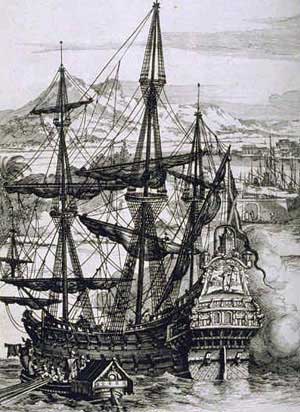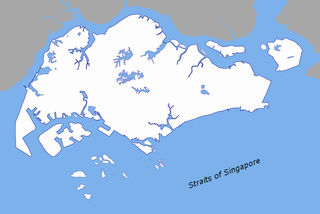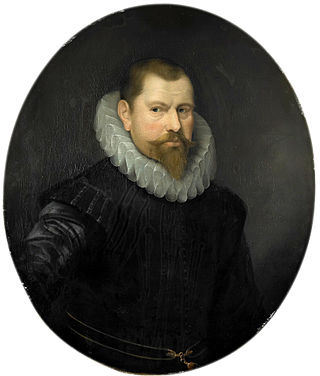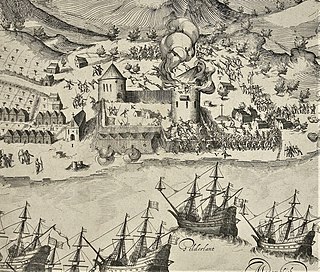
Galleons were large,multi-decked sailing ships developed in Portugal and Spain and first used as armed cargo carriers by Europeans from the 16th to 18th centuries during the Age of Sail and were the principal vessels drafted for use as warships until the Anglo-Dutch Wars of the mid-17th century. Galleons generally carried three or more masts with a lateen fore-and-aft rig on the rear masts,were carvel built with a prominent squared off raised stern,and used square-rigged sail plans on their fore-mast and main-masts.

The Singapore Strait is a 113 km-long (70 mi),19 km-wide (12 mi) strait between the Strait of Malacca in the west and the South China Sea in the east. Singapore is on the north of the channel,and the Indonesian Riau Islands are on the south. The two countries share a maritime border along the strait.

Cornelis Matelief de Jonge was a Dutch admiral who was active in establishing Dutch power in Southeast Asia during the beginning of the 17th century. His fleet was officially on a trading mission,but its true intent was to destroy Portuguese power in the area. The fleet had 1400 men on board,including 600 soldiers. Matelieff did not succeed in this. The Dutch would ultimately gain control of Malacca more than thirty years later,again joining forces with the Sultanate of Johor,and a new ally Aceh,in 1641. He was born and died in Rotterdam.

Pedro Bravo de Acuña was a Spanish military officer and colonial official in the New World and the Philippines. From 1602 to 1606 he was the eleventh governor of the Philippines.
Juan Niño de Tabora,was a Spanish general and colonial official. From June 29,1626,until his death on July 22,1632,he was governor of the Philippines.

The Battle of Cape Rachado,off Cape Rachado in 1606,was an important naval engagement between the Dutch East India Company (VOC) and Portuguese Navy.
François Wittert was a Dutch admiral in the service of the Dutch Republic.

The Battles of La Naval de Manila or Battle of Manila Bay were a series of five naval battles fought in the waters of the Spanish East Indies in the year 1646,in which the forces of the Spanish Empire repelled various attempts by forces of the Dutch Republic to invade Manila,during the Eighty Years' War. The Spanish forces,which included many native volunteers,consisted of two,and later,three Manila galleons,a galley and four brigantines. They neutralized a Dutch fleet of nineteen warships,divided into three separate squadrons. Heavy damage was inflicted upon the Dutch squadrons by the Spanish forces,forcing the Dutch to abandon their invasion of the Philippines.

The Treaty of Zaragoza or Saragossa,also called the Capitulation of Zaragoza or Saragossa,was a peace treaty between Castile and Portugal,signed on 22 April 1529 by King John III of Portugal and the Habsburg emperor Charles V in the Aragonese city of Zaragoza. The treaty defined the areas of Castilian and Portuguese influence in Asia in order to resolve the "Moluccas issue",which had arisen because both kingdoms claimed the lucrative Spice Islands for themselves,asserting that they were within their area of influence as specified in 1494 by the Treaty of Tordesillas. The conflict began in 1520,when expeditions from both kingdoms reached the Pacific Ocean,because no agreed meridian of longitude had been established in the far east.

The Battle of Gibraltar took place on 10 August 1621,during the Eighty Years' War between the Spanish Empire and the Dutch Republic. A Dutch East India Company fleet,escorted by a squadron under Willem Haultain de Zoete,was intercepted and defeated by nine ships of Spain's Atlantic fleet under Fadrique de Toledo while passing the Strait of Gibraltar.
Sultan Alauddin Riayat Shah III was the Sultan of Johor and reigned from 1597 to 1615. He resided at the new capital of Johor at Batu Sawar,but later moved his administration to Pasir Raja around 1609. In 1612,at the instigation of his co-ruler and half-brother Abdullah,and Bendahara Tun Sri Lanang oversaw the editorial and compilation process of the Malay Annals,one of the most important Malay literary works.
Sultan Abdullah Ma'ayat Shah was Sultan of Johor from 1615 to 1623. Before he became sultan of Johor,Abdullah Ma'ayat Shah was also known as Raja Bongsu,Raja Seberang or Raja di Hilir. Kota Seberang was described as the personal "fiefdom" of Raja Bongsu by Admiral Cornelis Matelief de Jonge. He controlled the settlement which was located almost straight across the Johor River from the royal administrative center and capital Batu Sawar. He is also said to have controlled areas around the Sambas River on the island of Borneo.

Fort Oranje is a 17th century Dutch fort on the island of Ternate in Indonesia.

Fort Tolukko is a small fortification on the east coast of Ternate facing Halmahera. It was one of the colonial forts built to control the trade in clove spices,which prior to the eighteenth century were only found in the Maluku Islands. It has been variously occupied by the Portuguese,the native Ternate Sultanate,the Dutch,the British and the Spanish. It was abandoned as a fort in 1864,renovated in 1996,and is now a tourist attraction.

Andrés de Alcaraz was an auditor licentiate taking over military affairs before becoming the 15th governor-general of the Philippines of the Philippines under Spanish colonial rule. He is the second governor-general of the Philippines from the Real Audiencia of Manila.

Malacca,officially the Historic State of Malacca,is a state in Malaysia located in the southern region of the Malay Peninsula,facing the Strait of Malacca. The state is bordered by Negeri Sembilan to the north and west and Johor to the south. The exclave of Tanjung Tuan also borders Negeri Sembilan to the north. Its capital is Malacca City,which has been listed as a UNESCO World Heritage Site since 7 July 2008.

The Battle of Aceh was fought in 1569 off the coast of Sumatra between a lone Portuguese carrack and an armada of the Sultanate of Aceh,that was about to stage an attack on Portuguese Malacca. It ended in Portuguese victory and the withdrawal of the Aceh fleet after suffering heavy losses.
Sultan Mudafar Syah I,also spelt Muzaffar Syah,was the ninth Sultan of Ternate who ruled from 1606 to 1627. He reigned during an important transitional phase,when the Dutch East India Company gained ascendency in the Maluku Islands and began to regulate the commerce in spices. This was the beginning of the colonial subordination of Maluku that would accelerate during his successors.

The Ternatean–Portuguese conflicts were a series of conflicts in the Spice Islands in eastern Indonesia between the Portuguese and their allies on one hand,and the Sultanate of Ternate and its allies,on the other. Hostilities broke out from time to time after the establishment of Portugal in Moluccas in 1522. The strongly Catholic and Muslim identities of the combatants gave the struggle elements of a war of religion,although this aspect was frequently blurred by cross-faith alliances. It was also an economic war since the Portuguese aim was to control export of the profitable trade in cloves. Portuguese-Ternatan rivalry later merged with attempts of expansion by the Spanish in the Philippines. The Portuguese were eventually defeated in 1605 by an alliance between the Dutch East India Company (VOC) and Ternate,ending their active involvement in Moluccas affairs. However,they were soon replaced by the Spanish who maintained an Iberian presence in the region up to 1663.
The Battle of Formoso River of 1615 was an naval battle that took place in the Malay Peninsula in the Formoso River,between a Portuguese fleet and a large fleet of the Sultanate of Aceh,one of the largest Aceh had ever mobilized against the Portuguese in Malacca.















